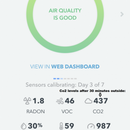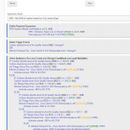Comments on Air Things and Ecowitt Air Quality Sensors for demand control of ventilation
In keeping with this winter’s theme of improving/monitoring indoor air quality, I added a device to the house automation complement yesterday, the Air Things Wave Plus. The black version is currently on sale, so I figured I’d check it out. This device measures radon, VOCs, CO2, pressure, temp and humidty. I set it up in our basement, where radon monitoring makes sense.
The HRV air exchanger in the house will now respond to VOCs as well as CO2 levels in the house. Radon monitoring needs to done for at least 30 days with the Air Things Wave plus to establish a rolling average, but so far the levels are ok. 4 pCi/L is a target threshold for remediation.
Waving a hand in front brings up the LED ring which is color coded for air quality. It ships with a magnetic base, is battery powered only, with a battery life of 1.5 years on 2 x AA cells. It can connect to an Air things hub via radio (for regular updates to the cloud), but out of the box will connect to your phone via bluetooth, which in turn updates to the cloud. So without the Air Things hub, or an Air Things View Plus (their premium air quality device, which has a WIFI hub integrated and can be powered by USB), the Wave plus alone, is great for monitoring air quality, but not great for running automation (as your phone would need to be present at home). Add an Air Things hub (which I’m doing) and it’s all good.
The Air Things Wave Plus includes a magnetic base that allows you to remove the Air Things device to change AA batteries or take it outside to calibrate.
I’m also using an Ecowitt WH45 which does not measure VOC or radon, but does measure CO2, PM2.5, PM10, and temp/humidty. The Ecowitt device is cheaper, can be powered by USB ( for more frequent updates) and does not require internet, or a cloud account. This makes it a good choice for automation with a system like Hubitat. You do need to purchase a WIFI gateway for the Ecowitt sensors, in this case a GW1100 (the grey device with LED lights), which allows you to access or upload data from the WH45 sensor (or any other Ecowitt device) on your home network.
I placed both of these sensors outside for 30 minutes and you can see that for CO2 (see attached pics), they are pretty darn close to what they should be reading outside, 420-430 ppm. Air Things suggests you expose their sensors to fresh air weekly to calibrate VOC and CO2. Ecowitt includes a calibration reset button at the base of the WH45, so you can take it outside and check to see if it reads close to 420 ppm CO2. If not, you can calibrate to 420 ppm using the reset button.
Here’s the Hubitat code (attached pic) that changes the air flow based on CO2 levels, and now VOCs. So far, activities like cooking, my daughter burning scented candles, and hair spray use (three girls in the house) will cause PM2.5 (ultra fine particles that can reach your blood stream via lungs) and VOC (volatile organic compounds) to noticeable spike. The HRV will now jump up to 90 CFM if VOC levels exceed 130 ppb.
If the induction cooktop is in use, the kitchen exhaust fan will fire up and change speed based on power use, while the HRV is put into “make up air” mode where it delivers an extra 60 CFM of positive pressure to the house.
You can find instructions to add an Air Things air quality device to a Hubitat automation hub here:
https://community.hubitat.com/t/air-things-view-plus/94434/125
Instructions to add the Ecowitt WH45 devices to a Hubitat hub are here:
If you wanted just one device to measure Radon, VOC, CO2, PM2.5, Temp, Pressure and Humidity then the Air Things View Plus ( https://www.airthings.com/en-ca/view-plus ) is worth a look. It can serve as a wireless hub for other Air Things sensors, and also connects to your house WIFI to regularly update the cloud. It does require cloud access to setup, and uses an API to allow an automation hub like Hubitat to access sensor data via the cloud. In other words, if your internet is down, an automation hub like Hubitat cannot see Air Things sensor updates. The Air Things View Plus is powered by six AA cells, but importantly, can be connected to USB for power…a better choice if using it in automation.
The Ecowitt WH45 and WIFI gateway do not measure Radon or VOC, but can function just fine without internet or cloud access. You can set up cloud access optionally at ecowitt.net which provides free long term graphing of sensor parameters and access to your air quality data when away from your home.
I hope this information proves useful 🙂
GBA Detail Library
A collection of one thousand construction details organized by climate and house part














Replies